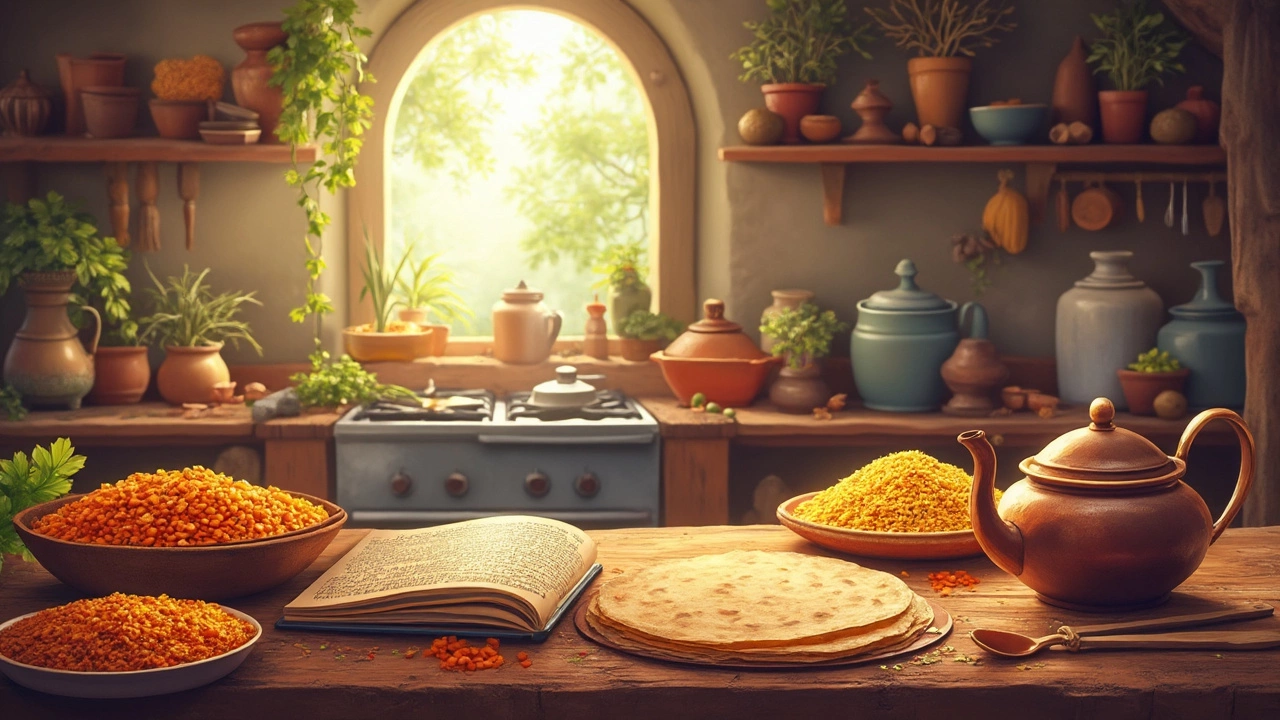When you think about dosa, you're probably imagining those crispy, thin pancakes that are just too good to be true. But let's face it, their high glycemic index can be tricky if you're watching your blood sugar. So, how do we turn these delicious treats into something that's easier on the body?
First off, look at the ingredients you're using. White rice is a staple in traditional dosa batter, but swapping it for brown rice or even incorporating whole grains like quinoa can make a difference. These alternatives have a lower glycemic index, keeping blood sugar levels more stable.
Adding fiber-rich ingredients isn't just good for digestion; it's also helpful in lowering the glycemic index. Think lentils, chickpeas, or even oats in your batter. They not only add texture but keep you full for longer.
- Understanding Dosa and Its Glycemic Index
- Choosing the Right Ingredients
- Incorporating Fiber and Protein
- Role of Fermentation in Lowering GI
- Practical Tips for Healthier Dosa
Understanding Dosa and Its Glycemic Index
So, let's talk about dosa and why its glycemic index (GI) gets all the attention. For those who don't know, the glycemic index is a measure that ranks foods according to their impact on your blood sugar levels. Low GI is good; high GI, not so much—especially if you're managing conditions like diabetes.
The traditional dosa, made primarily from white rice and urad dal, tends to sit higher on the GI scale. Why? Well, white rice is a refined grain, and refined grains generally have a higher glycemic index compared to whole grains. That means after eating a regular dosa, you might experience a quicker rise in blood sugar.
Why Glycemic Index Matters
If you're wondering why you should care, here's the deal: foods with a high GI can lead to sudden spikes and crashes in energy, making you feel tired or even hungry right after eating. For those keeping tabs on their blood sugar for health reasons, this isn't great news.
Low GI dosa options are better at providing a slow and steady release of energy, which means you stay fuller for longer and your body doesn't have to work overtime to manage blood sugar levels.
Comparing Glycemic Index of Ingredients
Let's dive into some numbers for a quick comparison:
| Ingredient | Approximate GI |
|---|---|
| White Rice | 73 |
| Brown Rice | 50 |
| Quinoa | 53 |
| Urad Dal | 35 |
See the pattern? Transitioning from white rice to something like brown rice or quinoa can drastically lower the GI of your beloved dosa. Thanks to these swaps, you can enjoy healthy dosa that are not only tasty but also gentler on your blood sugar levels.
Choosing the Right Ingredients
Crafting the perfect dosa batter recipe starts with picking the right ingredients. If you want to make your dosa low glycemic, the ingredients you choose play a huge role. Let’s break it down and see what swaps and additions can do that magic.
Swap White Rice with Whole Grains
Traditional dosas usually use a lot of white rice, which is tasty but not always the best for those watching their sugar. Switching to brown rice can immediately lower the glycemic index. Brown rice has more fiber and nutrients because it's less processed.
If you’re looking to mix things up, adding quinoa or millet can also help. Not only do these grains have a lower GI, but they also bring in extra protein and amino acids.
Introducing Legumes and Pulses
Adding more legumes into the batter is another smart move. You can try incorporating lentils like moong dal or chana dal. They pack in fiber and protein, helping slow down sugar absorption in the blood.
- Chickpeas: Add ground chickpeas (also known as besan) to your batter for a nuttier flavor.
- Masoor Dal: This red lentil is a great addition, enhancing both taste and nutrition.
Adding Seeds and Nuts
Don’t overlook the magic of seeds and nuts. Adding flaxseeds or chia seeds increases healthy fats and fibers in the batter. Ground almond meal could be another addition—it's subtle but effective.
Quick Nutritional Snapshot
| Ingredient | Glycemic Index |
|---|---|
| White Rice | 73 |
| Brown Rice | 50 |
| Quinoa | 53 |
| Moong Dal | 38 |
Switching ingredients might feel like a bit of a task initially, but just taking some time to mix these into your kitchen routine will yield healthier, tastier dosas that don’t spike your blood sugar. That's a win-win!

Incorporating Fiber and Protein
Boosting the fiber and protein content in your dosa batter recipe is a fantastic way to lower its glycemic index without losing that beloved flavor. You'll be making it heartier and more satisfying while keeping those blood sugar spikes at bay.
Why Fiber Matters
Fiber slows the absorption of sugar into your bloodstream, which helps prevent those unwanted sugar highs and crashes. It's easy to include more fiber in your dosa. Try adding ingredients like oats, lentils, or peas right into your batter. Did you know that a cup of cooked lentils contains around 15 grams of fiber? That's a neat way to bulk up your meal!
Protein for the Win
Protein doesn't just build muscles; it also slows down digestion, helping to lower the glycemic index of your dosa. Throw in some chickpea flour to your mix, or try blending cooked quinoa into the batter. Both pack a powerful protein punch and add some delightful texture to your dosa.
Combining Fiber and Protein
For the ultimate low GI dosa, why not combine both fiber and protein-rich ingredients? Let's say you use a ratio of half brown rice, a quarter oats, and a quarter lentils for your dosa batter. It’s a combo that keeps you full longer and aids in controlling your blood sugar. Here's a simple starting point:
- 3/4 cup brown rice
- 1/4 cup oats
- 1/4 cup lentils
- 1/4 cup chickpea flour
Soaking these overnight before blending them into a batter helps in fermentation and unlocks their full potential.
| Ingredient | Protein per cup |
|---|---|
| Chickpea Flour | 22 grams |
| Quinoa | 8 grams |
| Oats | 5 grams |
By making these easy swaps and pairings, you're not only boosting the nutritional value of your dosa but also making it a healthier, more balanced choice. Say goodbye to post-meal sugar crashes and hello to a deliciously satisfying dosa experience!
Role of Fermentation in Lowering GI
Fermentation is like magic for food, and it's one of the secret weapons in your kitchen when aiming to make a healthy dosa. The process of fermenting dosa batter isn't just about flavor; it actually plays a big role in minimizing the glycemic index. So, how does it work?
Fermentation breaks down the complex carbohydrates into simpler forms, which are easier to digest. This means that the glucose release during digestion is more gradual, leading to a lower glycemic index. In simple terms, it slows down the rate at which sugars enter your bloodstream.
Getting the Fermentation Right
Timing is everything here. Too short, and you won't get the full benefits; too long, and the batter might turn too sour. Aim for about 8-12 hours, ideally overnight, in a warm place. This gives the natural bacteria enough time to do its thing.
- Avoid over-fermenting as it might make the batter too acidic.
- Use a ceramic or glass bowl for best results since metal can interfere with the fermentation process.
Adding Extra Ingredients
Adding a spoonful of fermented foods like yogurt or a bit of cooked rice to your dosa batter recipe can kickstart the fermentation. The natural bacteria in these foods accelerate the process and can even improve the texture of your dosa.
Overall, taking the time to properly ferment your batter isn't just a step in making dosa; it's crucial if you're aiming for that appealing balance of taste, texture, and health. So, don't skip it!

Practical Tips for Healthier Dosa
If you love dosa but worry about its glycemic impact, there are straightforward adjustments you can make. Let's get into some hands-on tips to make your dosa both delicious and health-friendly.
Switching Up the Grains
One of the simplest changes is swapping out white rice for alternatives that have a lower glycemic index. Use brown rice or better yet, mix in quinoa or millets with the usual rice. These not only reduce the GI but also increase nutritional value.
Add More Fiber
Fiber slows down the digestion of carbohydrates, which helps in controlling blood sugar spikes. Consider adding ingredients like oats, barley, or even finely chopped vegetables to your dosa batter recipe. Plus, they add a nice texture!
Protein Boost
Proteins are essential for a balanced diet, and they also lower the glycemic load of meals. Try incorporating legumes such as lentils or chickpea flour. A bit of yogurt or milk can also give the batter a protein-rich twist.
The Magic of Fermentation
Certain bacteria produced during fermentation can reduce the GI of foods. Always allow your dosa batter to ferment well before using. Not only does it bring out a better taste, but it also makes your healthy dosa gut-friendly.
Use Smart Cooking Techniques
Avoid using too much oil when cooking. Instead, opt for non-stick pans or just a light spray of oil. And remember, while crispy edges are tempting, cooking them less can actually keep the GI lower.
Sample Glycemic Index Table
| Type | Glycemic Index |
|---|---|
| White Rice Dosa | 73 |
| Brown Rice Dosa | 55 |
| Quinoa Dosa | 53 |
Small changes can go a long way in transforming your dosa into a healthier option. Experiment with these tips and find what's most appealing to your taste buds without compromising on health. You'll be surprised at how versatile and delicious a low GI dosa can be!
